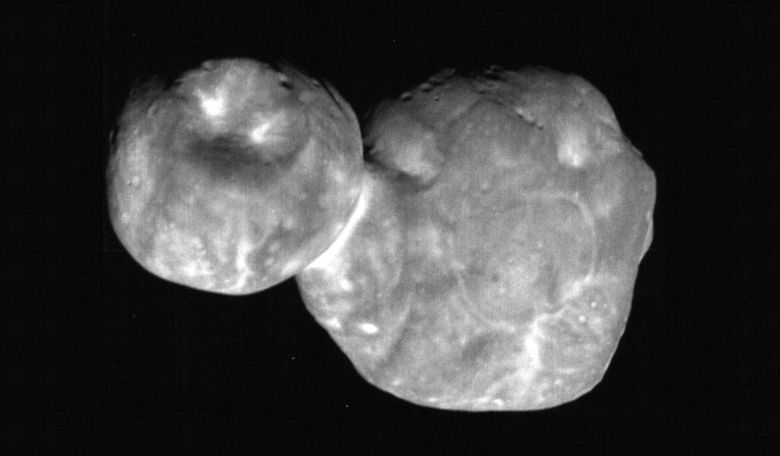When pictures of a flattened, red-tinged ancient snowman-shaped object floating around beyond the orbit of Pluto wowed the scientific community earlier this year, not much else was known about NASA’s New Horizons new target - a primordial rock known as (486958) 2014 MU69, also informally known as Ultima Thule. Now the first initial scientific results from the flyby are in and an analysis of these features could help researchers piece together clues about how the planets were formed.
Located about 1.6 billion kilometres farther from the Sun than Pluto was at the time of the New Horizons flyby, Ultima Thule comes from a region known as the Kuiper belt; a broad, ring-shaped structure in the outer Solar System beyond Neptune’s orbit, which contains chunks of primitive icy material thought to be the building blocks of planets.
Ultima Thule is a typical example of a “cold classical” Kuiper Belt object (CCKBO), where cold in this instance does not refer to its surface temperature but instead describes the orbits of the objects, along with the amount of influence Neptune's gravity has had on them.
Its distinctive shape is the result of a gentle merger of two independently formed bodies, as evidenced by a lack of features showing an energetic or violent merger. In fact, it is likely, say the team behind the mission, whose lead author on the recent research paper is Alan Stern, principal investigator of the New Horizons mission, that it only took a gravitational infall speed of several meters per second for the two objects to join together.
CCKBOs are thought to be the least dynamically evolved population in the Solar System and because this cool variety of classical KBOs have not wandered over a large range of distances from the Sun since they formed, unlike their ‘hot’ more meandering companions, they have never been warmed above ~60 kelvin (-213 celsius).
As such, say the team, not much on the surface of Ultima Thule has changed since it was first formed approximately 4.5 billion years ago. And neither has its immediate surroundings as no evidence of an atmosphere, or any moons, rings or dust clouds were found orbiting this huge, cold distant relic from the early Solar System. This somewhat monotonous existence over the eons can therefore provide clues about the conditions that gave birth to the planets, and one place to start is how it looks; squashed and relatively hum-drum in appearance.
Many planetary scientists believe that the first stage of planet formation is the accumulation of dust and ice grains into millimetre and centimetre-sized pebbles. These pebbles can then clump together to form gravitationally bound pebble clouds. As they jostle around inside such a cloud, the pebbles will stick to one another and as the cloud loses heat and energy over time, it gradually contracts. This pushes the ever-growing pebbles into larger and larger boulder-sized objects and eventually they will collide to form bigger bodies like planestimals.
This type of process is called a pebble cloud collapse model and Stern and colleagues suggest that Ultima’s flattened shape and its two lobes which are strikingly similar in surface albedo, colour and composition, are a likely result of this primitive object forming in such a way, from a single source of material.
If that’s the case, then the material that makes up Ultima Thule, could also provide answers to what type of molecules were available when the building blocks of the Solar System were being produced.
Spectroscopic analysis of this bilobate shaped rock with New Horizon’s Linear Etalon Imaging Spectral Array (LEISA), reveals that its red colouring could be due to tholin-like complex organic macromolecules, produced from simpler species.
Tholins are a broad class of complex organic molecules that are typically formed when ultraviolet light strikes simple organic molecules such as methane (CH4). This process knocks out hydrogen atoms which are then lost to space, allowing for longer-chain chemical reactions to take place involving carbon or nitrogen. Tentative fingerprints of methane, along with water ice have potentially been observed on Ultima by LEISA, say Stern and colleagues in their paper.
Because of our high-oxygen atmosphere which tends to prevent them from forming, tholins don’t exist naturally on Earth, but they are very common on the cold worlds of the outer solar system such as Pluto. Indeed the New Horizons mission was key in identifying similar spectral features found on the large, dark red equatorial region of this dwarf planet informally called Cthulhu.
It has been proposed that Pluto is in fact one giant comet, made up of roughly a billion smaller objects that are similar in composition to 67P/C-G, the comet surveyed by Rosetta. If Ultima Thule turns out to be made of the same stuff, perhaps that could help shed light on Pluto’s formation.
However there is a long way to go yet before all of the data analysis on Ultima Thule is complete as according to Stern and colleagues the insights gained in this study are based on only about 10 percent of the total data collected during the flyby; the full data transmission from the spacecraft to Earth is expected to be finished in 2020.











